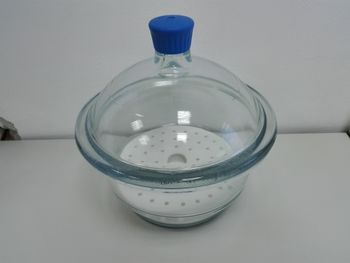Desiccator
 |
This article is a stub. Please help Sciencemadness Wiki by expanding it, adding pictures, and improving existing text.
|
Desiccators are sealable enclosures containing desiccants used for drying wet materials and preserving moisture-sensitive materials for long-term use.
Contents
Description
A desiccator consists of a container, usually made out of glass, or rarer plastic or metal. The container consists or a main body and a (heavy) lid. The lid presents a ground-glass rim which is greased with a thin layer of vacuum grease or other lubricant to ensure an airtight seal. The interior is separated in two my a mesh or sieve, with the desiccating agent being placed below and the wet material being placed above, on the mesh.
There are actually several types of desiccators:
- Classic desiccator: The glass dome-like model is the most common type of desiccator. It is widely used due to its good performance and simple construction.
- Vacuum desiccator: Similar in construction to the classic model, the main difference is the addition of a valve on the top of the lid. This desiccator can be used for stronger and faster drying. An vacuum pump is used to pump out the air from inside the chamber.
- Bag desiccator: Made from a resealable bag, where the wet material and the desiccant are placed in separate containers. The advantage of this desiccator is that it doesn't occupy lots of space, unlike the other desiccators. However, their biggest disadvantage is that it's quite easy to damage and thus it's easy to ruin the dry atmosphere.
Whenever the desiccators are opened, their contents are exposed to atmospheric moisture. It also requires some time to achieve a low humidity, making them unsuitable for fast drying. Desiccators are only suitable for drying materials which are not aggressively hygroscopic and are not sensitive to low humidity. They are unsuitable for drying and storing materials that are very sensitive to atmospheric moisture or that irreversible hydrolyze.
Availability
Glass desiccators can be purchased from lab suppliers and online, from eBay and Amazon.
DIY desiccator
A simple desiccator can be made by using an air-tight tupperware container, where the drying agent is placed in an open container, while the wet material is placed near it, in a separate open container, like a plate. Other air-tight containers, like those used to store food will also work.
Bag desiccators can be made by using readily available resealable bags, which can be bought from any hardware and bookstore. If perforation of the bag is a real possibility, you can strengthen the bag by adding duct tape over it and check for holes.
Placing a smaller desiccator in a bigger one may not always be required, though gloveboxes are exceptions.
Projects
- Dry chemicals
- Store hygroscopic or mild water-sensitive materials
- Transporting sensitive materials from and inside gloveboxes
Handling
Desiccators are easy to maintain, but being made of glass means they can break if dropped to a hard surface. Since they are much thicker than other lab glassware, it can be quite heavy, which increases the risk of damaging the desiccator. Desiccator's ground-glass outer rim is known to chip if hit.
Plastic bag desiccators are fragile and should be kept either on a plate or in a safe place.
